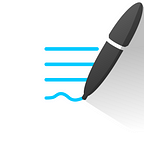Document management on the iPad made easy — Interview with Gerrit Vanoppen
We have talked to one of our long-time users to find out what he uses GoodNotes for. We were quite astonished by some of his clever workflows and structures. Enjoy reading and get inspired.
Hi Gerrit, please tell us a bit about your work and your background.
I’ve been an architect for the largest part of my career, something like 32 years. Around 2009 I felt that business was changing in many ways, in fact too many for me. So I closed down my office and went to work with a software distributor. Our firm has been growing these past years, and I’m now the Software Development Manager. This puts me in charge of a yearly release of our software — including localization, translation, development, and documentation. I’m guiding a team of developers and a team of technical writers, 9 people in total, working in our Belgium and Poland offices.
How and when did you discover GoodNotes?
My first iPad was a 2 series, so that takes us back about 3 to 4 years — if I remember correctly. The first app I purchased was actually a simple drawing app, I forgot the name and I no longer use it. It wasn’t until about a half year later that I started to use my iPad for note taking. I started with reading app reviews, something I still do now. GoodNotes 3 was receiving very good comments on the internet, so I decided to purchase it. GoodNotes 4 was a giant step forward at the time of its release, I gladly upgraded and never looked back.
In which work-related context are you using GoodNotes?
Actually, there are multiple contexts:
1. Journals
I create one notebook per month, kind of a journal. They’re simply named 2016–02, 2016–03 etc. and they’re in the “No Category”. During workdays, my iPad is always next to me with GoodNotes ready to use. Any loose scribbles go into the journal of the month. Some of them are later processed into project notebooks (see later), others are just temporary notes or sketches while discussing things with my co-workers. Either way, I review my journal a couple of times a week, mostly in the evening as my homework.
2. Project Notebooks
Over time, I managed to classify my actual work into 6 main categories. I use abbreviations like [PRG], [OFF]… I use these everywhere: as GoodNotes categories, but also as Finder labels on my Mac. While reviewing my month journal, some of the information is copied over into these project notebooks. However, most of the content is created directly into the appropriate notebook. Typically, this would be meeting notes, concept drawings, reminders, schemes etc.
3. Annotating PDFs
While I leave my MacBook Pro in the office at night, I use my iPad at home for things I can do in the evening. In my specific case, it’s often about reviewing translations from my technical writers. To do that, I save these documents as pdf, upload them to Dropbox or Google Drive — to open in GoodNotes later on.
4. Reference Libraries
Recently, I started to use GoodNotes to store all kinds of pdf documents and images that I used to store in p.e. iBooks. It took a while to change habits, but now it feels good to have everything into one app.
Tell us about the effect of using GoodNotes on your team’s performance.
GoodNotes has a lot of import and export possibilities right at hand, and very easy to figure out. This has allowed me to develop and support a very smooth workflow where lots of information are channeled in. Images, sketches, pdf documents, text snippets, handwritten notes and concept drawings… they all find their way into my GoodNotes library. I typically use all that stuff in my notebooks to set up meeting agenda’s, document meeting minutes, pass along new concept designs to the developers etc. My team members have come to appreciate my ways of creating content this way, after all they can store it so easily as pdf. At the same time, I upload a lot from within GoodNotes to our Google Drive. There, it’s available to everyone in the team.
Which advantages do you see in handwritten notes, compared to the functions on your computer?
Much has been written about the advantages of handwritten notes as opposed to typed ones. I agree with most of the arguments. Handwriting feels like being more focused, I somehow think deeper because I want to capture exactly what I should write down. I can write faster by hand than typing, but I still don’t want to write down every word that comes to mind before giving it some consideration. Somehow, handwriting creates a certain margin for that.
When I organise or moderate a meeting, or even attend someone else’s, I never take my MacBook with me. I hate it when people around the table start to flap their laptops open, it looks like a wall of screens that allow no more real physical contact. I use my iPad with GoodNotes and my Bamboo stylus instead.
Another thing that I don’t see me doing on my MacBook Pro, is to annotate my own notes. Indeed, after a meeting or a brainstorming session, I like to go through my notes again. Add some, delete some, and rearrange other.
This is so easy and smooth in the GoodNotes app.
Gerrit shares great learning resources and free custom templates for GoodNotes on his Youtube channel.
